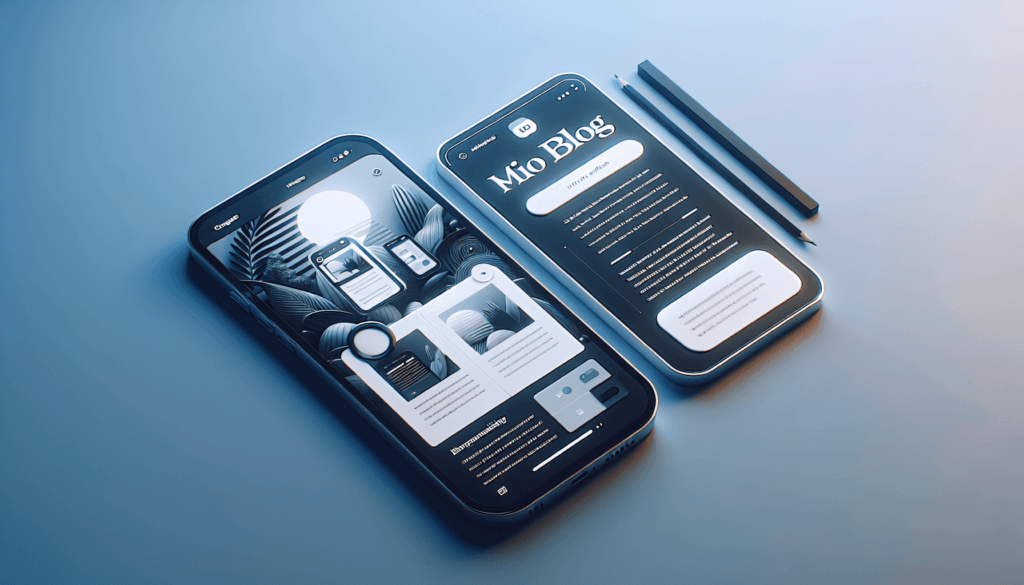Are you looking to start a blog that can be accessed easily on mobile devices? Look no further! Our article, “Beginner’s Guide To Creating A Mobile-Friendly Blog,” is here to help you get started. In this guide, we will provide you with essential tips and tricks to ensure that your blog is not only visually appealing but also easily navigable on smartphones and tablets. From choosing the right responsive design to optimizing your content for mobile viewing, this article has everything you need to know to create a successful mobile-friendly blog. So, grab your device, get comfortable, and let’s dive into the world of mobile blogging!
Choose a Mobile-Friendly Blogging Platform
When it comes to choosing a mobile-friendly blogging platform, you have several options to consider. One of the most popular and widely used platforms is WordPress. With countless mobile-friendly themes and plugins available, WordPress allows you to easily create a responsive blog that can adapt to different screen sizes. Blogger and Squarespace are also worthy contenders, with built-in mobile optimization features. Before making a decision, consider your blogging needs, budget, and the level of customization you require.
Select a Mobile-Optimized Theme or Template
Once you have chosen your blogging platform, the next step is to select a mobile-optimized theme or template. Research different options available for your chosen platform, such as themes specifically designed to be mobile-friendly. Look for themes that offer responsive design, as they will automatically adjust to fit any screen size. It is important to check the responsiveness of the theme on different devices and ensure a seamless user experience. Once you have selected a theme, customize it to reflect your unique style and branding.

Optimize Your Blog Content for Mobile
To ensure your blog is mobile-friendly, it’s essential to optimize your content for a smaller screen size. Focus on readability by using legible fonts and a font size that is easy to read on mobile devices. Break up your content into shorter paragraphs and sentences, as large blocks of text can be overwhelming on a small screen. Utilize headers and subheaders to make your content scannable and visually appealing. Optimize images for mobile by compressing their file size and ensuring they load quickly. Lastly, aim for fast page load times as mobile users tend to have less patience.
Implement Responsive Design Techniques
Implementing responsive design techniques is crucial to ensuring your blog looks great on all devices. Understanding responsive design principles is key to creating a flexible and fluid layout that adjusts according to screen size. Use fluid grid layouts to allow your content to adapt to different screen sizes seamlessly. Apply flexible images that can scale and maintain aspect ratio on any device. Media queries can be used to target specific screen sizes and adjust the layout accordingly, enhancing the user experience.

Use Mobile-Friendly Navigation Menus
Navigation menus are an important aspect of a mobile-friendly blog. To create a user-friendly experience, it is essential to eliminate clutter and simplify menu options. Consider using a mobile-specific menu that is easy to navigate on smaller screens. A hamburger menu icon is a popular choice, as it conserves space while providing access to the full menu when tapped. Ensure that your navigation is intuitive and easy to use, allowing readers to explore your blog effortlessly whether they are on a desktop or a mobile device.
Make Your Blog Load Faster
A fast-loading blog is crucial for mobile users who are often on the go and have limited time and patience. To optimize your blog’s loading speed, compress and optimize images to reduce file size without compromising quality. Minify CSS and JavaScript files by removing unnecessary code and white spaces to make them load faster. Enable browser caching to store static files and assets, reducing the load time for returning visitors. Additionally, consider leveraging Content Delivery Networks (CDNs) that distribute your content across multiple servers, reducing the distance it needs to travel and improving load times.

Test Your Blog on Various Mobile Devices
To ensure a seamless mobile experience, it is essential to test your blog on various devices. Use developer tools to emulate different mobile devices and preview how your blog appears and functions. Perform cross-browser testing to ensure compatibility across different web browsers used on mobile devices. Check for responsiveness by resizing browser windows to simulate different screen sizes and orientations. By testing your blog on various devices, you can identify and address any layout or functionality issues, ensuring a consistent experience for all users.
Optimize Your Blog for Mobile Search Engines
To boost your blog’s visibility on mobile search engines, implementing mobile SEO best practices is crucial. Optimize metadata and page titles by including relevant keywords that target mobile users. Create mobile-friendly URLs that are clean, concise, and descriptive. This not only improves search engine optimization but also enhances the user experience. Ensure proper mobile indexing by creating a mobile sitemap and submitting it to search engines. By optimizing your blog for mobile search engines, you increase the chances of attracting organic traffic to your mobile-friendly blog.

Ensure a Consistent User Experience Across Devices
Providing a consistent user experience across devices is essential for retaining and engaging your readers. Test the user experience on different screens, including mobile phones and tablets, to make sure your blog is visually appealing and functional on all devices. Avoid using Flash and pop-ups, as they may not be supported on all devices and can hinder the user experience. Instead, focus on touchscreen-friendly interactions that allow readers to easily navigate and interact with your blog’s content. By prioritizing a consistent user experience, you create a positive impression and encourage users to visit and revisit your mobile-friendly blog.
Monitor and Analyze Your Mobile Visitors
Monitoring and analyzing your mobile visitors can provide valuable insights into their behavior and help you make informed decisions to improve your blog. Utilize web analytics tools to track mobile traffic and gain an understanding of your audience’s demographics, preferences, and engagement. Analyze user behavior on mobile devices, such as their click-through rates, time spent on your blog, and popular content. By collecting and analyzing data, you can identify patterns, make data-driven improvements, and tailor your blog to meet the needs and preferences of your mobile audience.
Creating a mobile-friendly blog is crucial in today’s digital landscape, where more people access the internet through mobile devices than ever before. By choosing a mobile-friendly blogging platform, selecting a responsive theme, optimizing your content, implementing responsive design techniques, using mobile-friendly navigation, optimizing load times, testing on various devices, optimizing for mobile search engines, ensuring consistency across devices, and monitoring user behavior, you can create a blog that provides an exceptional user experience across all devices. With a mobile-friendly blog, you can cater to the growing number of mobile users and effectively reach and engage your audience on the go.



